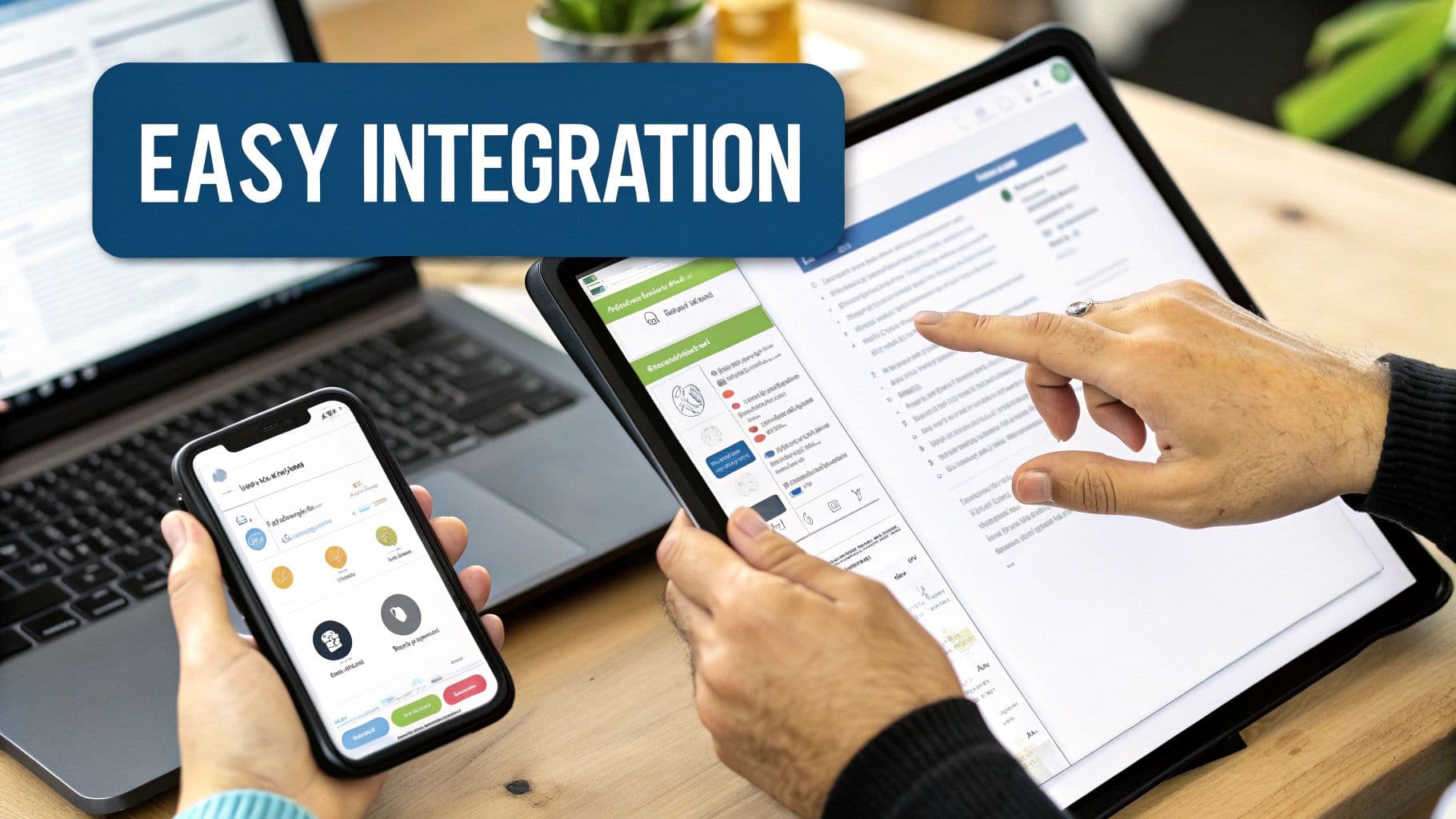Think of remote team collaboration software as the digital headquarters for a team that isn't physically in the same room. It's the central spot where everyone comes together to talk, plan, and create—without being bogged down by a dozen different apps for messaging, project management, and file sharing. This unified hub keeps work flowing smoothly and helps the team feel connected, no matter how far apart they are.
Building a Digital HQ with Remote Team Collaboration Software

It helps to picture it as your physical office, just brought online.
In this virtual headquarters, you have dedicated "rooms" for project discussions, "hallways" for those quick, informal chats, and a shared "library" where all your team's knowledge is stored.
- Rooms: Perfect for focused teamwork and real-time brainstorming sessions.
- Hallways: Great for the kind of casual watercooler conversations that build team bonds.
- Library: A central, searchable place for documents, notes, and past decisions.
This kind of structure directly combats the isolation and disjointed workflows that can plague remote teams by giving them a familiar, organized space to work in.
What These Tools Actually Do
At its core, this software is designed to replicate the essential functions of an office, just in a digital format. It keeps communication, projects, and knowledge all in one easily accessible place.
Here’s a quick breakdown of what these platforms handle:
Core Functions of Remote Collaboration Software
| Function Area | Key Purpose | Example Tools |
|---|---|---|
| Communication | Keeps everyone connected with real-time chat and video calls. | Slack, Zoom |
| Project Management | Makes it easy to track tasks and see project progress at a glance. | Trello, Asana |
| Knowledge Sharing | Creates a central repository for information that’s easy to search. | Confluence, Notion |
| File Collaboration | Allows for secure document editing and keeps track of versions. | Google Drive |
It's no surprise that the global market for this software was valued at USD 36.1 billion in 2024. It’s expected to grow to USD 57.4 billion by 2030, with a steady 7.4% growth rate each year, all thanks to the increasing need for these all-in-one digital workspaces. You can read the full market report on team collaboration software growth to see the data for yourself.
By bringing tasks, messages, and files together, these tools give everyone on the team a clear view of what’s happening, which fosters a real sense of ownership.
Here’s a snapshot of how these digital hubs boost productivity:
- Quick, instant access to the right conversation channels and documents.
- Less time wasted switching between a dozen different applications.
- Automated notifications and reminders that keep tasks from falling through the cracks.
Connecting People, No Matter Where They Are
One of the biggest struggles for remote teams is feeling disconnected or siloed. When conversations happen in scattered emails and private chats, it’s easy to lose context.
A digital HQ solves this problem by creating a transparent environment where you can see who’s online and what they’re focused on.
This means a manager in Berlin can easily jump into a brainstorming session happening with their team in Tokyo without feeling like they’ve missed the whole conversation.
- A designer in Brazil shares a new prototype in the dedicated project "room."
- A developer in Canada pops in to leave feedback right there in the same space.
- A marketer in India quickly checks the "library" to review decisions from a previous meeting.
Another massive benefit is the built-in search functionality. It turns every past conversation, decision, and document into a living, searchable knowledge base for the entire team. To get the most out of this, you'll want to be sure you're capturing information effectively. We have a guide on how to take better meeting notes that can help with that.
Ultimately, a well-designed digital HQ helps your team stop worrying about how to get work done and focus on the work itself. By mirroring the collaborative zones of a physical office, this software nurtures connection, clarity, and creativity across any distance.
Getting Your Digital HQ Off the Ground
Ready to start? Don't try to boil the ocean.
Start by mapping your current tools to the office analogies—which app is your "hallway"? Which is your "library"? Pick one project "room" to test out first.
After a week or two, gather feedback from the team to see what’s working and what isn’t. Tweak your setup from there.
And don't forget to celebrate the small wins. It makes all the difference.
The Core Features Your Team Will Actually Use
Walking into the "collaboration software" aisle feels overwhelming. Hundreds of tools flash shiny features, all promising to fix your team's remote work problems. But here’s the secret: you don’t need the tool with the most features. You need the one with the right features.
Think of it like a chef's kitchen. A great chef doesn't need a gadget that can chop, blend, and bake all at once (and do it all poorly). They need a razor-sharp knife, a reliable stove, and a solid set of pans. For your remote team, the principle is the same. Focus on the core tools that solve real, everyday headaches.
This is what happens when teams nail the essentials.

As you can see, getting the software right means communication becomes a central hub, projects gain clarity, and your team feels more efficient and connected.
H3: Communication That Builds Clarity, Not Clutter
The bedrock of any high-functioning remote team is crystal-clear communication. But let's be honest, most generic chat apps are a firehose of notifications where crucial information gets swept away in minutes. Good software is designed to fix that.
The one feature that makes all the difference? Threaded conversations. This sounds simple, but it’s a game-changer. Instead of one chaotic river of chat, discussions about a specific project or task are neatly nested together. Anyone can jump into a topic, get up to speed quickly, and contribute without having to read through a dozen unrelated conversations. It turns a noisy room into a well-organized library.
H3: Project Management That Everyone Understands
One of the biggest struggles for remote teams is visibility. Who’s working on what? Is that project on track? Without a shared space to see progress, accountability gets fuzzy and deadlines start slipping.
Your software needs to bake project and task management right into the conversation. Forget switching to another app. The best tools let you:
- Visualize the workflow: Think of digital Kanban boards with columns like "To Do," "In Progress," and "Done." They provide a perfect at-a-glance status update for the whole team.
- Assign clear ownership: Every task needs a name and a due date. It’s non-negotiable.
- Break down the work: Large projects feel less daunting when you can break them into smaller checklists and subtasks. Nothing gets missed.
When you can discuss a task, assign it, and track it all in one place, things just get done.
H3: File Sharing and a Searchable Knowledge Base
How much time does your team waste asking, "Hey, where's that file again?" When documents are scattered across emails, personal drives, and random cloud accounts, you’re not just losing time—you're creating confusion.
Look for secure file sharing with version control. This feature alone prevents the nightmare of someone editing an old version of a document, saving hours of rework. But the real powerhouse is a universal search function. The ability to instantly pull up a file, a decision, or a specific chat from six months ago is priceless. Your platform stops being just a communication tool and becomes your team's collective brain.
H3: Integrations That Unify Your Workflow
Let's face it, no single app can do everything perfectly. The smartest collaboration platforms know this. They act as a central hub, a digital headquarters that connects to all the other specialized tools your team already relies on.
A rich library of integrations is what stops the productivity-killing "app switching" madness. For example, look at what Zoom did with the launch of Zoom Workplace in 2024. They brought meetings, chat, and document collaboration under one roof, then supercharged it with AI. More importantly, they connect with over 2,500 other applications.
This shows you the modern approach: a central platform that coordinates work across all your other tools, no matter where your team members are. As you can read more about the evolution of collaboration tools, you'll see this trend is key. A tool with great integrations can grow and adapt right alongside your team.
Feature Comparison Across Collaboration Tool Tiers
Not all tools are created equal, and pricing tiers often dictate the features you get. Here’s a quick breakdown of what you can generally expect at different levels.
| Feature Category | Free Tier (Typical) | Mid-Range Tier (Common) | Enterprise Tier (Advanced) |
|---|---|---|---|
| Communication | Basic chat, limited message history, limited video call participants. | Unlimited message history, advanced search, guest access, full-featured video meetings. | SSO, data loss prevention (DLP), compliance exports, guaranteed uptime SLAs. |
| Project Management | Simple to-do lists, limited number of active projects or boards. | Unlimited projects, visual boards (Kanban), timelines, basic reporting. | Advanced workflow automation, portfolio management, in-depth analytics. |
| File Storage | Limited total storage (e.g., 5-10 GB per team). | Increased storage per user (e.g., 10-20 GB per person), basic version control. | Unlimited storage, advanced security controls, granular permissions, e-discovery. |
| Integrations | Handful of core integrations (e.g., Google Drive, Calendar). | Hundreds of integrations with popular business apps (e.g., Salesforce, Jira). | Custom API access, bespoke integrations, dedicated integration support. |
This table gives you a general idea of the landscape. As you move up the tiers, you're not just getting more features—you're getting more power, security, and customization to fit the unique needs of a growing or complex organization.
How to Choose the Right Software for Your Team

Picking the right collaboration software for your remote team can feel completely overwhelming. With so many options out there, it’s easy to get paralyzed by the fear of making the wrong choice.
But here’s the secret: the goal isn’t to find a "perfect" tool. It’s to find the tool that’s a perfect fit for your team’s specific rhythm and workflow.
Think of it like buying a car. A zippy sports car is fun, but it’s a terrible choice for a big family. A minivan is practical for hauling kids and gear but might be way too much for a solo commuter. The right choice is all about your actual needs, not just a long list of fancy features. In the same way, the best software should bend to how your team already works, not force everyone into a new and clunky process.
This whole journey starts with an honest look at your team's day-to-day reality, not a feature checklist.
Start by Assessing Your Team’s Reality
Before you even start browsing software websites, just stop. Take a step back and really analyze how your team operates right now. You need to pinpoint the real pain points a new tool could solve, not just the ones you think you have.
Get together with your team and ask some tough questions:
- Where do things fall apart? Do communication breakdowns happen most often during project handoffs? Are people getting lost in endless email chains?
- What does our project workflow actually look like? Try to map it out from beginning to end. Is it a straightforward, assembly-line process, or is it more creative and unpredictable?
- How are we sharing and storing files? Do we have an organized central hub, or are critical documents scattered across desktops, inboxes, and random folders?
- What tools are we already paying for? Getting a handle on your current "tech stack" is key to avoiding redundant tools and ensuring any new software plays nicely with others.
This self-audit gives you a clear blueprint of what you actually need. It shifts the focus from "what shiny new features are out there?" to "what specific problems are we trying to fix?"
Prioritize Must-Have Integrations
No collaboration tool exists in a vacuum. The best ones act as a central hub, seamlessly connecting to the other apps your team uses every single day. Without solid integrations, you get "tool sprawl"—a frustrating reality where everyone is constantly flipping between tabs, copying and pasting data, and wasting time.
Make a list of your absolute, non-negotiable integrations. For instance:
- Sales Team: The software absolutely must integrate with your CRM, like Salesforce.
- Development Team: It needs to connect with your code repository (like GitHub) and your issue tracker (like Jira).
- Marketing Team: You'll need tight integration with file storage (like Google Drive) and design tools (like Figma).
When a platform has a rich ecosystem of integrations, it doesn't become another silo. It becomes the connective tissue that holds your entire workflow together.
Focus on Security and Scalability
It might not be the most exciting part of the process, but you can't afford to treat security as an afterthought—especially with a distributed team. You don't have to become a cybersecurity expert, but you do need to look for basics like data encryption and user access controls that let you manage who can see and do what.
Scalability is just as important. Your team might be small now, but what about in two years? The right software should be able to grow with you.
Thinking ahead like this will save you a world of headaches, time, and money down the road.
Run a Pilot Program Before You Commit
Never, ever make this decision based on a demo alone. The people who will be living in this software every day are the only ones who can tell you if it’s any good. Once you've narrowed your choices down to two or three top contenders, it’s time for a test drive.
Pull together a small group of employees from different departments to try each platform on a real, short-term project. This is about more than just checking off features; it’s about feeling out the actual user experience. After the trial, get their brutally honest feedback. This is also a great chance to see how the tool affects your meetings; you can check out our guide on how to run effective team meetings that drive results to set some ground rules.
Ask your test group:
- Was it easy to figure out? Or was the learning curve a nightmare?
- Did it actually make your job easier? Or did it just add more steps to your workflow?
- Did you run into any frustrating roadblocks?
- On a scale of 1-10, would you actually want to use this every day?
This kind of firsthand feedback is priceless. It’s what ensures the tool you pick will actually get used and loved by your team, becoming a true asset instead of another forgotten subscription.

